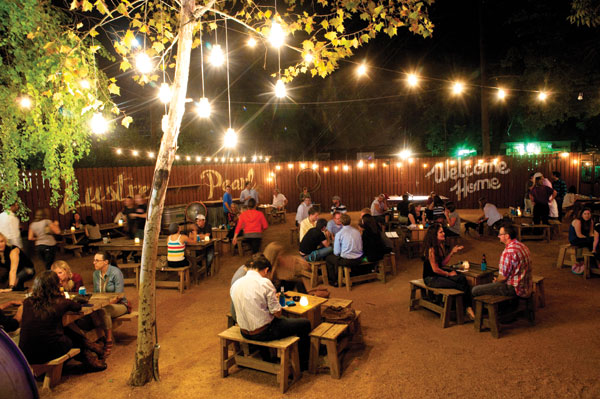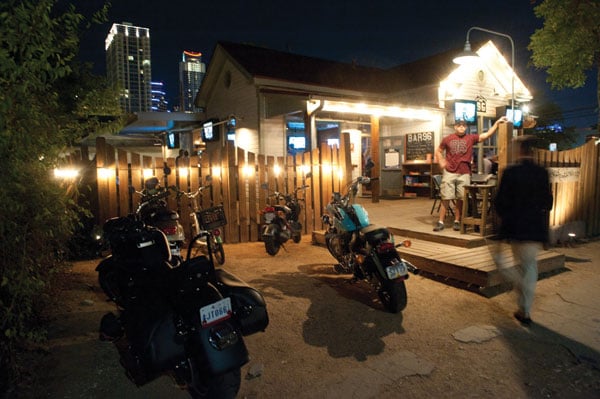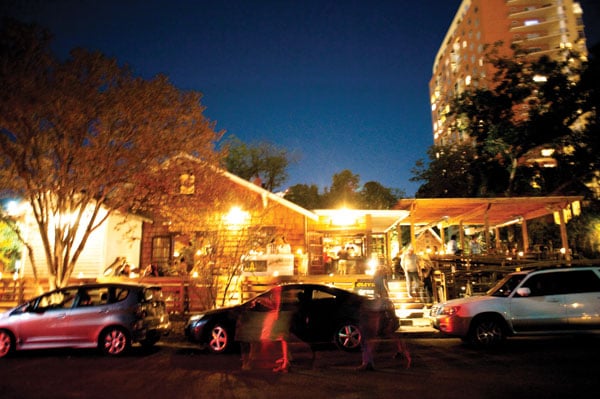Priced Out in the Shadow of Downtown Austin
On a warm Friday night in Austin, people stroll down Rainey Street, heading to a handful of bars and restaurants, mindful of the stream of cars along the way. Clive Bar, in a small, pale-green bungalow, and Lustre Pearl, in a pastel-colored Victorian house, are the main attractions on this once-residential street. The website for Lustre Pearl calls it “the Rainey Street bar that started it all.” But started what?
The bar’s owner—along with some developers, residents and city planners—says Lustre Pearl, the first bar on the street, launched a new chapter in the near-downtown neighborhood’s history, transforming it into a destination like the city’s South Congress area. Other residents and community leaders say the bar hastened the neighborhood’s decline, driving away the mostly working-class Latino families who lived there.
Until it was rezoned as a business district in 2005, the neighborhood was residential, single-family homes mingled with a few local businesses. Within walking distance of downtown, the Rainey Street neighborhood spans just half a mile. It may be small, but what is happening here says something important about how Austin, which has mushroomed to more than 800,000 people, and cities like it are changing. Neighborhoods close to downtown, especially communities of color, are becoming increasingly unaffordable as the central city once again becomes a desirable place to live.
Supporters of downtown development argue that dense urban cores make cities safer, more economically viable, and better for the environment. Opponents counter that low-income and working-class people are being priced out of the central city, as their communities become playgrounds, like Rainey Street, for more affluent residents. Some longtime residents must decide if they will go or stay; others don’t have a choice.
On this Friday night, cars crawl down the street past darkened houses. Some are derelict, with “For Sale” signs visible under the streetlights. A man stands at his front door, leaning on the frame, watching the bar and restaurant patrons parading by.

Outside seating at Lustre.
“We loved Rainey Street, but now it’s gone to pot,” Richard Sanchez told me, as he stood on his front porch. Sanchez, who is in his 60s, has lived in the neighborhood since he was a young boy. He co-owns a bungalow on Rainey Street that was built in 1907. He is trying to sell it.
“Family can’t come visit me, because there’s no parking,” he complained, adding that the noise from the bars makes it hard for him to sleep at night. He’s had to call the police on several occasions when parked cars blocked his driveway.
Sanchez has fond memories of growing up on Rainey Street in the 1960s and 1970s—playing football, riding bikes, staging mock battles in the woods and fishing nearby. “Waller Creek and Town Lake, those were our playgrounds! You could catch a 20- to 30-pound catfish with a cane pole,” he recalled. “And when it flooded, man, you saw everyone down there fishing because you could see the backs of the fish.”
He attended University Junior High School, one of the first Austin schools to desegregate in the 1950s, and Austin High School. His parents shopped at Jim Dandy’s, a convenience store and grocery that allowed customers to buy on credit.
The neighborhood was mostly Latino then, Sanchez said. But there were also white hippies and artists. “It was shady, it was laid-back,” he said. “And you could smell the tortillas cooking in the afternoon.”
Over the years, residents have come and gone on Rainey Street; the houses tell the story of change.
Before it was Clive Bar, 609 Davis Street (at the corner of Rainey and Davis streets), was a home. Rufus and Elizabeth Waterston built the modest bungalow in 1926. They joined a tree-lined neighborhood close to the commerce and bustle of 6th Street and Congress Avenue, but far enough away to feel almost secluded. The east corner of their house looked out on Rainey Street. A veteran of World War I, Rufus was a carpenter, contractor and stonecutter who likely found plenty of work in the steadily growing capital.
Sixten and Elin Johnson bought the house in 1952, the same year that Massengale Meat and Poultry Company opened on Red River Street, a block to the west. Sixten worked as a roofer and as a janitor at the Travis County Courthouse. He and Elin lived in the house for at least 35 years.
In the early ’60s, the construction of Interstate 35, which replaced East Avenue, sealed the separation of white downtown from the black and Latino communities east of the freeway. The interstate also isolated Rainey Street; many people argue that the division enabled the neighborhood’s slow decline. But it was still a growing neighborhood. The Johnsons saw several Hispanic families move onto Rainey Street, including the Sanchezes.

Bar 96.
Since the 1980s, developers dreamed of building high-rise hotels, condominiums, offices and even a convention center—which came to fruition in the early 1990s—a stone’s throw from the neighborhood. Many of the old homes had absentee landlords, and by the 1970s and 1980s several of the houses had fallen into disrepair.
In part to protect against development, in 1985 the Rainey Street neighborhood was listed on the National Register of Historic Places. Austin developer Perry Lorenz said a few Rainey Street residents and outside activists promoted the listing to prevent the convention center from being built in the neighborhood. Lorenz, who has served on the city’s Design Commission for many years, claims the designation had a chilling effect on growth because developers mistakenly thought they couldn’t alter the buildings.
Then came the tech boom of the 1990s. Money flowed into the city, and neighborhoods close to downtown, especially East Austin, felt tremendous development pressure. Susana Almanza, a co-founder of the nonprofit People Organized in Defense of Earth and her Resources (PODER), said people started buying properties in East Austin in significant numbers by 1998. She said the increase was due in part to the national Smart Growth movement, which advocates dense, mixed-use neighborhoods where businesses and residences co-exist to reduce sprawl and protect the environment. State Sen. Kirk Watson, D-Austin, was mayor at the time and a proponent of Smart Growth, as were several City Council members, environmentalists and community leaders.
City leaders also wanted a bigger tax base to boost public coffers. With denser growth, downtown Austin’s tax base would grow. Cities across the nation had recognized that inner-city areas where poorer residents lived produced less tax revenue. City officials tried to counter the pattern by encouraging downtown developments with greater property values aimed at wealthier residents.
Rising property values means rising property taxes. Increased property values may benefit owners who want to sell, but the taxes can undermine those who want to stay. Property taxes in many parts of East Austin increased in proportion to property values throughout the 1990s and 2000s with the influx of new businesses, condo developments and renovated homes. Suddenly lifelong residents had difficulty paying their taxes. Many families were forced to sell their homes; others owed a small fortune in back taxes. Renters suffered too as rents rose along with property values.
Austin developed a shortage of affordable housing. In 1999, the Community Action Network, a partnership of community leaders and housing advocates, released a seminal report on the problem. It found that a rapidly increasing population—150,000 people moved to Austin between 1990 and 1999—combined with uneven wage growth and a lack of affordable housing, had caused a significant housing gap in the city. Home prices increased by 71 percent in that same period, and in 1998 it was estimated that more than 40 percent of Austin renters couldn’t afford a market-rate apartment based on the federal standard for affordable housing, which is no more than 30 percent of annual household income. The problem rippled across the city and engulfed Rainey Street.

Clive Bar.
In the 1990s, Rainey Street residents fought zoning changes and the new development they would bring, said City Planner Jerry Rusthoven. But gradually many homeowners realized that some development in the neighborhood would raise property values and allow them to sell at competitive prices, he said.
“When the [choice to rezone] came, we thought it was a great idea,” said Richard Sanchez, whose family hoped to sell their home and purchase a new place outside of Austin. Over the course of 10 years, developers, homeowners and city planners discussed rezoning Rainey Street for commercial development. Developer Perry Lorenz and his partner Robert Knight worked with resident and property owner Bobby Velasquez to promote the densest possible zoning for the area—Central Business District.
Former City Council member Brigid Shea, who at the time lived at 609 Davis Street, initially resisted the zoning change. But when the majority of her neighbors expressed support for it, she shifted her position. “If this is what everybody really wants, then let’s work together as a neighborhood and figure out the best way to have everyone benefit,” she said at the time.
In the early 2000s, the best way seemed to be selling as a group to developer Gordon Dunaway. Residents were offered as much as $450,000 for their properties, depending on lot size, as long as a majority agreed to sell. The project had the necessary majority, but at the last minute, a couple of property owners backed out and the deal fell through.
Rezoning, and then selling, still seemed to be the best option. Richard Sanchez said he and several neighbors were advised that rezoning their neighborhood would open it up to hotels, condominiums and other commercialization, and that the value of his land would skyrocket. “The idea was that we would have zoning for high-rise development,” Lorenz said. But that’s not exactly what happened, at least not right away.
After more than two years of public meetings with the city and the Planning Commission, the City Council finalized Rainey Street’s rezoning as a business district in April 2005. The neighborhood seemed poised for redevelopment, but a sluggish economy held it at bay for a couple of years. Some residents who thought they could sell their homes right away for great prices didn’t get those offers. Others decided to rent out their properties to businesses. That’s how Clive Bar came about.
Shea and her family lived at 609 Davis for more than a decade, until they began renting their house to entrepreneur Bridget Dunlap. A few years ago, Dunlap had spotted a crumbling Victorian at the top of Rainey Street. She decided to rent it and open a bar she called Lustre Pearl in 2009. That same year, she opened Clive Bar. Bar 96 followed, and Dunlap plans to open Container Bar, built of shipping containers, on New Year’s Eve.
Dunlap said her bars have had a positive effect on the neighborhood. Fixing up the Lustre Pearl house rather than bulldozing it and building high-rises has helped to preserve the historic character of the neighborhood, she said. Cleaning up the property and drawing new patrons to the area benefits the community, especially “considering what the neighborhood was when I came in,” she said. “There were mattresses, there were needles, there were prostitutes … this was a known place to get drugs.”
When I asked Sanchez about prostitutes and drugs on the street before the bars were established, he scoffed: “I don’t know anything about that.”
Dunlap acknowledged that property taxes have risen, but she noted that’s because property values have risen as well. She suggests that neighbors who are unhappy with the way the neighborhood has developed should sell their homes at a good price and live somewhere else. She doesn’t think there should be affordable housing in the neighborhood for working- and middle-class residents who want to remain.
Selling has benefitted some people in the neighborhood. Leonard Briseño grew up on Rainey Street, where he and his wife owned four consecutive lots. The Briseños just sold three of those lots to JMI Realty, which says it doesn’t yet have a development plan for the properties. Lilie Briseño, Leonard’s daughter, lives in the fourth house. “Other than the parking,” she told me, “I love the neighborhood.”
She likes how close it is to downtown, and doesn’t mind the noise and activity on the street. That proximity is the biggest impetus behind the changes on Rainey Street—and one of the biggest barriers to affordable housing here.
The Community Action Network recommended several proposals to address the affordable-housing shortage in the late 1990s. Austin’s SMART Housing program, which stands for Safe, Mixed-income, Accessible, Reasonably priced and Transit-oriented, attempted to act on several of them. Unlike some affordable-housing initiatives that tend to concentrate affordable housing in one area or outside of cities, the SMART housing plan aimed to provide affordable housing throughout the city, including areas in and close to downtown.
On Rainey Street, Shea told me, several neighbors pushed hard for an affordable-housing provision in the area’s rezoning: specifically, a requirement that developers provide affordable housing in exchange for allowances to build higher than city code allows. In the end, a provision was included in the rezoning, but it required only that 5 percent of units built above the height limits be affordable. There was no time limit on the affordability clause, so after tenants and owners moved out of affordable units, owners could rent and sell at market rates.
A 2008 program allowed developers to build higher than city regulations as long as 10 percent of the new units were offered as affordable housing. Ian Stonington sold the units at The Shore Condominiums on Red River Street in the Rainey Street neighborhood. Stonington, who lives in the condos, is also president of the Rainey Street Neighborhood Association. He says affordable housing could happen in the area “if incentivized.”
Twelve of the 192 units at The Shore Condominiums were originally offered as affordable housing, Stonington told me. No new projects have been built under the 2008 program, because developers have cheaper and easier options outside of the program for building higher and denser projects, Jim Robertson of the Neighborhood Planning & Zoning Department explained. It might be too optimistic to hope that the people who used to live on Rainey Street when it was residential and mostly low-income will one day live in the sleek high-rises dotting the neighborhood. The reality is that most will live in Pflugerville, Bastrop, Del Valle and other communities outside of Austin, where housing remains relatively affordable. The median home price in the Austin area was $194,600 this year, about $10,000 more than the median national home price. Meanwhile, incomes in Austin have remained stagnant since 2001, according to city demographer Ryan Robinson.
It would take a tremendous effort by the city, community leaders and developers to keep Rainey Street affordable for the people who used to, and still do, live there. And in the end, those people may not choose to stay regardless.
“We don’t want to leave it,” Sanchez said. But he and his family have put their house on the market. A bar will be moving in next door, and another across the street. He’s tired of struggling with the noise, the traffic, the parking and everything else that comes with living on Rainey Street these days.
Native Austinite and chef Sidney Roberts returned to Austin in 2008 and opened the G’Raj Mahal Cafe, a casual outdoor restaurant, a year later. Roberts said, “one of my heartaches when I moved back to Austin was seeing it whitewashed, and I wanted to maintain the character … and what better than [with] lovely food and drinks.”
Like Bridget Dunlap, Roberts thinks it’s better to repurpose existing houses and land rather than raze them and build high-rises. It’s important to preserve the residential character of the neighborhood, Roberts said. “I guess because I was so conscious that this was a neighborhood, I play music that’s not going to carry out, even if we get permitted … it’s all acoustic, and it doesn’t travel outside of the property,” she told me.
As I walked away from the G’Raj Mahal, the restaurant’s live music faded before I left the empty lot next door. On Rainey Street, cars waited for parking. A man vomited out the passenger window of a car as it inched along. Across the street, Lustre Pearl had just a few patrons at picnic tables, but the night was still young.
Hannah Carney is a freelance writer based in Austin.


